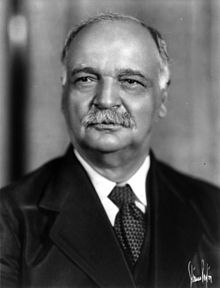Charles Curtis
| Charles Curtis | |
|---|---|
 |
|
| 31st Vice President of the United States | |
|
In office March 4, 1929 – March 4, 1933 |
|
| President | Herbert Hoover |
| Preceded by | Charles G. Dawes |
| Succeeded by | John Nance Garner |
| Senate Majority Leader | |
|
In office March 4, 1925 – March 4, 1929 |
|
| Deputy | Wesley Jones |
| Preceded by | Henry Cabot Lodge |
| Succeeded by | James Watson |
| Senate Majority Whip | |
|
In office March 4, 1915 – March 4, 1925 |
|
| Leader | Henry Cabot Lodge |
| Preceded by | James Wadsworth |
| Succeeded by | Wesley Jones |
| President pro tempore of the United States Senate | |
|
In office December 4, 1911 – December 12, 1911 |
|
| Preceded by | Augustus Bacon |
| Succeeded by | Augustus Bacon |
|
United States Senator from Kansas |
|
|
In office March 4, 1915 – March 4, 1929 |
|
| Preceded by | Joseph L. Bristow |
| Succeeded by | Henry Allen |
|
In office January 29, 1907 – March 4, 1913 |
|
| Preceded by | Alfred W. Benson |
| Succeeded by | William Thompson |
| Member of the U.S. House of Representatives from Kansas's 1st district |
|
|
In office March 4, 1899 – January 28, 1907 |
|
| Preceded by | Case Broderick |
| Succeeded by | Daniel Anthony |
| Member of the U.S. House of Representatives from Kansas's 4th district |
|
|
In office March 4, 1893 – March 4, 1899 |
|
| Preceded by | John G. Otis |
| Succeeded by | James Miller |
| Personal details | |
| Born |
January 25, 1860 Topeka, Kansas, U.S. |
| Died | February 8, 1936 (aged 76) Washington, D.C., U.S. |
| Political party | Republican |
| Spouse(s) | Annie Baird (1860–1924) |
| Children | 3 |
| Signature | |
Charles Curtis (January 25, 1860 – February 8, 1936) was an American attorney and politician, elected as the 31st Vice President of the United States (1929–33) with President Herbert Hoover.
After serving as a United States Representative and being repeatedly re-elected as United States Senator from Kansas, Curtis was chosen as Senate Majority Leader by his Republican colleagues. Born in Kansas Territory to a mother of the Kaw Nation, Curtis was the first person with significant Native American ancestry and the first person with acknowledged non-European ancestry to reach either of the highest offices in the United States government's executive branch. He is notable also as an Executive Branch officer born in a territory rather than a state.
As an attorney, Curtis entered political life at the age of 32. He won multiple terms from his district in Topeka, Kansas, beginning in 1892 as a Republican to the US House of Representatives. He was elected to the US Senate first by the Kansas Legislature in 1906, and then by popular vote in 1914, 1920 and 1926. Curtis served one six-year term from 1907 to 1913, and then most of three terms from 1915 to 1929 (after his election as vice president). His long popularity and connections in Kansas and national politics helped make Curtis a strong leader in the senate; he marshaled support to be elected as Senate Minority Whip from 1915 to 1925 and then as Senate Majority Leader from 1925 to 1929. In these positions, he was instrumental in managing legislation and accomplishing Republican national goals.
Curtis ran for Vice President with Herbert Hoover as President in 1928. They won a landslide victory. When they ran together again in 1932, because Hoover had failed to alleviate the Great Depression, the public elected Democrats Franklin D. Roosevelt and John Nance Garner.
...
Wikipedia
